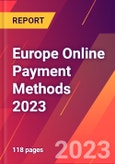European nations witness shift of consumers from conventional card-based online payment methods to alternative payment methods
As the global cashless era gains momentum, the total transaction value of digital wallets are projected to surge beyond EUR 10 trillion by 2028, at a remarkable CAGR of +12% between 2023 and 2028. Despite digital wallets' rise, Europe's payment landscape remains diverse, with each country showcasing varying preferences. In the Netherlands, iDEAL reigns supreme, constituting 70% of online purchases as of April 2023. Notably, contactless payments have seen widespread adoption, especially among the 25-34 age group, with a preference rate of 77% as of December 2022. Switzerland has become a stronghold for mobile payments, commanding the highest share in both volume (57%) and value (31%) for online transactions as of November 2022. Hungary is witnessing significant progress, with an estimated 80% of online stores now offering payment card and e-wallet solutions like Apple Pay and Simple Pay in 2023. As Europe's online payment market evolves, driven by technological advancements and innovative methods, it promises a dynamic future that shapes the way consumers pay and businesses operate.
Biometric authentication experiences tremendous growth potential as data security becomes a major issue
As consumers worldwide increasingly shift towards using online payment methods, they are also entrusting their financial data to various companies and payment service providers. This trend has resulted in the rise of payment-related frauds and scams, making data privacy and security paramount concerns for stakeholders in the payment industry. Notably, over half of the surveyed consumers expressed discomfort in sharing their financial data for online payments as of April 2023, according to the latest publication. In Germany, most respondents prioritized security and privacy when selecting a payment method, whereas in France, protection of privacy and data emerged as a leading consideration for over three-quarters of respondents during the checkout process. In response to this evolving landscape, payment authorities are actively exploring biometric authentication methods, including fingerprint, iris recognition, and voice recognition, among others, to enhance payment security. Moreover, there is a growing expectation that the future will witness the widespread adoption of digital IDs and virtual cards, further fortifying the safety and security of digital payments.
Questions Covered
1. What is the forecasted value of digital wallet transactions globally by 2028?
2. What is the number of cashless payment users in Europe as of 2023?
3. What is the forecasted number of proximity mobile payment users in the UK in 2026?
4. What was the number and value of contactless mobile transactions in Turkey as of Q1 2023?
Please note: For this report, the purchase of an Enterprise license allows up to ten worldwide users of an organization access to the report
Table of Contents
Companies Mentioned (Partial List)
A selection of companies mentioned in this report includes, but is not limited to:
- Affirm
- Apple
- Bancontact
- Bizum
- BLIK
- Dankort
- iDEAL
- Klarna
- Klarna
- Mir
- MobilePay
- Pay U
- Payconiq
- PayPal
- Przelewy24
- QIWI
- Samsung
- Sofort
- Swish
- Tpay
- YooMoney








